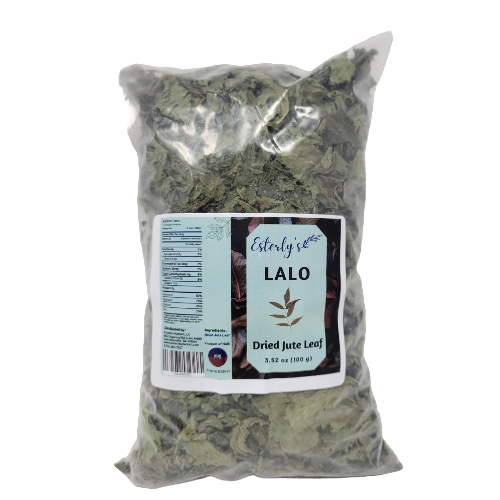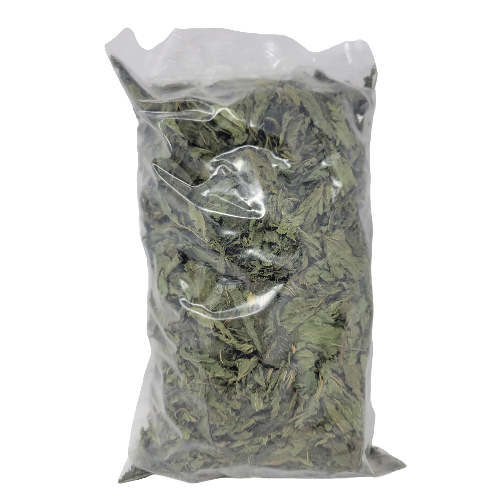Your cart is currently empty!
$17.99
Esterly’s Dried Jute Leaf
- Rich in essential vitamins and minerals, including vitamin C, iron, calcium, and potassium.
- High in fiber, which can aid in digestion and promote a healthy gut.
- Offers a unique flavor and texture, with a subtle sweetness and slimy texture when cooked.
- Versatile and easy to use in the kitchen, adding a delicious and nutritious boost to a variety of dishes.
- A great choice for vegetarians and vegans, as it is an excellent source of plant-based protein.
In stock
Description
Dried jute leaf (also known as lalo in Haiti, ewedu” in West Africa, molokhia in Egypt , and saluyot in Phillipines) is a nutrient-dense and delicious leafy green that is gaining popularity in the health food community. This leafy green is commonly found in tropical regions and has been used for centuries for its medicinal properties.
Dried jute leaf is a rich source of vitamins and minerals, including vitamin C, iron, calcium, and potassium, making it an excellent addition to any diet. It is also known for its high fiber content..
What sets dried jute leaf apart from other leafy greens is its unique flavor and texture. It has a subtle, slightly sweet taste that pairs well with a variety of dishes, from soups to stews to salads.
Not only is dried jute leaf a delicious and nutritious ingredient, but it is also versatile and easy to use in the kitchen. It can be added to smoothies, used as a garnish, or simply sautéed with other vegetables.
Overall, dried jute leaf is an excellent addition to any diet, providing a plethora of benefits and a unique, delicious flavor. So why not try adding some dried jute leaf to your next meal and discover the amazing taste for yourself?
Jute Leaves (Lalo) – Your Pathway to Health and Culinary Delight
In the vast and vibrant world of leafy greens, there exists a supremely nutritious and versatile plant known to many but still awaiting broader discovery by food enthusiasts and health-conscious eaters alike. The jute plant, specifically its leaves, often hailed as the unsung heroes of the culinary and medicinal plant kingdom. Jute leaves are also known as an essential ingredient in various dishes. Unwrap the mystique of Lalo, commonly known as dried jute leaf, and why it deserves a spot in your pantry and on your plate. Jute leaves are also known to offer numerous health benefits.
What Makes Lalo (Dried Jute Leaf) a Culinary and Medicinal Treasure?
Jute leaves, recognized around the globe by various names such as saluyot, ewedu, and mulukhiyah, depending on the region, form an integral part of numerous cuisines spanning across Haiti, Asia, the Middle East, Africa, and parts of the Mediterranean, like Egypt and Palestine. This leafy green, derived from the corchorus olitorius plant—a jute plant that’s mostly cultivated for its fibre (used in making twine and burlap)—is more than just the source of a durable material. When cultivated or cooked, these leaves transform into a powerhouse of nutrients and flavors, offering numerous health and culinary benefits, showing how jute leaves are used in various recipes.
Rich in vitamins A, C, and B6, folate, riboflavin (Vitamin B2), niacin, thiamine, beta-carotene, and minerals such as magnesium, these leaves are a potent anti-inflammatory and may help lower inflammation in the body. Their high vitamin C content not only boosts the immune system but also enhances iron absorption, closely mirroring the benefits of spinach but with its own unique twist, which is why jute leaves are also used in this context. The leaves are abundant in dietary fiber, contributing to digestive health, and jute leaves are also known for their antioxidant properties.
Culinary-wise, jute leaves are incredibly versatile. In their fresh or dried form (known as Lalo), they can be used to add a distinct flavor and texture to soups, stews, sauces, and even smoothies. When cooked, especially fresh leaves, they release a slimy mucilage, similar to okra, which acts as a natural thickener in dishes like soups and stews. This unique textural component is not just about mouthfeel but also adds to the dish’s nutritional profile, making Lalo a favored ingredient in the creation of healthful and satisfying meals.
From Farm to Table: How Jute Leaves Are Harvested and Used
The jute plant thrives in warm, humid climates, making it a staple in countries like Nigeria, Ghana, Egypt, and other parts of Africa and Asia. The plant’s leaves are most tender and flavorful when harvested young; however, the older leaves tend to be more fibrous and are usually used in slow-cooked dishes where they have time to soften, demonstrating that jute leaves may vary in use based on their age. Depending on how they are prepared, jute leaves can be cooked whole, loosely chopped, or blended to better integrate into various recipes.
Whether you’re looking to make a nourishing stew with ewedu or a invigorating soup made vibrant with molokhia, the jute leaf adapts to each culinary challenge it faces. Its ability to meld into both traditional and innovative dishes alike showcases its versatility and proves that this leafy green is more than just a side note in the culinary world, highlighting various culinary uses.
FAQ about Lalo
Q: What are the health benefits of jute leaves?
A: Jute leaves are rich in vitamins (A, C, B6), minerals (magnesium, iron), and antioxidants, making them exceptional for various culinary uses. They have anti-inflammatory properties, can help in lowering blood pressure, improving heart health, and are beneficial for digestion due to their high dietary fiber content.
Q: Can I eat jute leaves raw?
A: They are typically consumed cooked. Cooking them releases valuable nutrients and makes them easier to digest. Raw jute leaves may be tough and fibrous, especially the older ones.
Q: How do I incorporate dried jute leaves (Lalo) into my diet?**
A: Dried jute leaves can be rehydrated and used similarly to fresh leaves. They’re perfect for soups, stews, and as a nutritious addition to smoothies. They can also act as a thickener, offering a unique flavor and texture to your dishes. Jute leaves are used in many culinary traditions for this purpose.
The journey of exploring jute leaves, either as lalo, saluyot, ewedu, or by any other name it is known, is an adventure not just of taste but of health and culinary innovation. Jute leaves may offer a unique experience in diverse cuisines. As a leafy green that is as nutrient-packed as it is versatile, it beckons to be discovered and enjoyed in numerous forms. Whether you seek to enhance your diet, explore new culinary landscapes, or simply enjoy a wholesome meal, the jute leaf stands ready to transform your eating habits and your kitchen repertoire.
Additional information
| UPC |
|---|







Elaine –
No complaints whatsoever! There were maybe two brownish leaves I had to remove from the whole bag! Very clean and helped me create a DELICIOUS pot of Lalo! Will definitely purchase again!